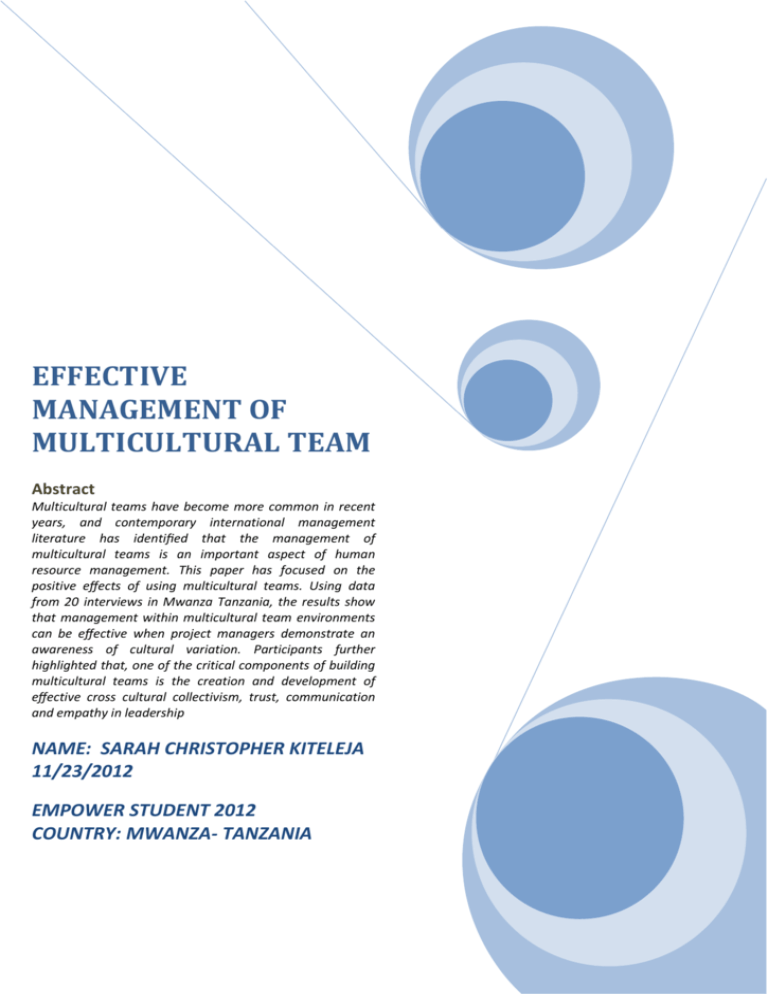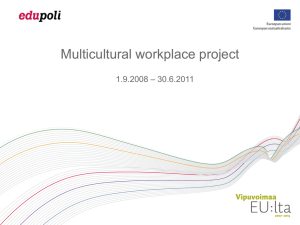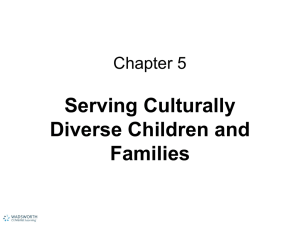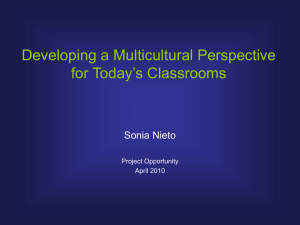EFFECTIVE MANAGEMENT OF MULTICULTURAL TEAM
advertisement

EFFECTIVE MANAGEMENT OF MULTICULTURAL TEAM Abstract Multicultural teams have become more common in recent years, and contemporary international management literature has identified that the management of multicultural teams is an important aspect of human resource management. This paper has focused on the positive effects of using multicultural teams. Using data from 20 interviews in Mwanza Tanzania, the results show that management within multicultural team environments can be effective when project managers demonstrate an awareness of cultural variation. Participants further highlighted that, one of the critical components of building multicultural teams is the creation and development of effective cross cultural collectivism, trust, communication and empathy in leadership NAME: SARAH CHRISTOPHER KITELEJA 11/23/2012 EMPOWER STUDENT 2012 COUNTRY: MWANZA- TANZANIA 1 Table of Contents 1. INTRODUCTION .................................................................................................................................. 3 1.2 Objective of diploma paper .......................................................................................................... 3 1.3 Significant of the study ............................................................................................................. 3 2. BACKGROUND OF THE PROBLEM ................................................................................................... 3-4 3. MANAGEMENT OF MULTICUTURAL TEAM…………………………………………………………………………………...4 3.1 Type of multicultural team & its diversity .................................................................................... 4 3.2 Condition for higher performance ......................................................................................... 4-5 3.3 management of Multicultural team……………………………………………………………………………..6-7 3.4 management of Multicultural team…………………………………………………………………………..7-9 4. THE USE OF DMIS IN MANAGEMENT OF MULTICUTURAL TEAM…………………………………………..10-12 5. CHALLENGES IN MANAGING MULTICULTURAL TEAM……………………………………………………………13-14 6. RECOMMENDATION………………………………………………………………………………………………………………15-18 7. CONCLUSION……………………………………………………………………………………………………………………………….19 8. REFERENCE…………………………………………………………………………………………………………………………………20 2 1. INTRODUCTION Multicultural teams have become very common in recent years. With cross border mobility becoming much easier the number of people moving from one country to another has grown significantly. This has also led to more people from different cultural and ethnic backgrounds intermarrying. Their children could be born and grow up in different countries and have hybrid cultural identities. Globalization and the advances in communication and transportation technology have reduced trade barriers and increased interaction among people. Multicultural teams have become more common in our organizations, and contemporary international management literature has identified that the management of multicultural teams is an important aspect of human resource management. Recent studies have focussed on the positive effects of using multicultural teams, for example, Earleyand Mosakowski (2000) stated that multicultural teams are used because they are perceived to out-perform monoculture teams, especially when performance requires multiple skills and judgement. However, there has been little research into construction-specific multicultural teams, and many construction organisations, although expanding into global operations do not fully appreciate the implications and are often unable to respond to cultural factors affecting their project teams. 1.1 Objective of the diploma paper To explain challenges faced by Multicultural team and how to manage them To give recommendations on effective management of multicultural team. 1.2 Significant of the study To explain to which extent the multicultural team can be managed To explain to which extent the multicultural team diversity can be used for the benefit of the organization. 2. Background of the Problem The nature of our workplaces has changed. We have moved away from the monochromic make-up of our offices to one that is now coloured by team members from all over the world. With this new multicultural make-up come differences in cultures which in turn bring differences in areas such as communication styles, approach to time, managerial styles and a plethora of other cross cultural differences. In Tanzania there is more than 122 ethnic groups and each group has its own culture and in one office is obvious to find more 3 than five ethnic group work together. In such kind of an office it needs a leader who is competent enough in management of multicultural team/workers. Cultural differences manifest in many ways. Within a multicultural team, a person's cultural background will impact how they act and behave. There will be differences in areas such as communication, attitude to towards conflict, approaches to task completion and decision making styles. Unless people come to realise these differences between them through cultural awareness, problems can continue and even intensify. Most of leaders in Tanzania are not competent enough to lead such group of people hence it leads to most of staffs to drop out their job. After working with different team members with different culture I realized that Cultural awareness is now crucial if multicultural teams within working place are going to maximise their potential. Although cross cultural differences do not always cause obvious problems, it is their more subtle manifestations that can and do lead to a lack of clear communication and poor performance. Also culture doesn’t always have to be about race ethnicity or religion, culture also encompasses how a group may identify themselves. 3. MANAGEMENT OF MULTICULTURAL TEAM 3.1 What is Multicultural Team? Multicultural team is a team with members coming from more than one culture.. And this is what is happening now in different working places. On other hand there is increasing attention being paid to the importance of multi-cultural teams, i.e. working teams within international business that can benefit from as wide a knowledge and understanding as possible of the different cultures that have a bearing on the world of commerce. As recruitment of managers becomes more global, the prevalence of multi-cultural teams becomes greater; there is a consequent need to analyze how these teams work and understand their strengths and weaknesses. 3.2 Types of Multicultural diversity in teams Multicultural teams can be divided into three types, Token teams having a single member from another culture, bicultural teams having members from two cultures and Multicultural teams having members from three or more cultures. TokenTeams In token teams all but one member comes from the same background. In the last decades, predominantly male management teams began to pay considerable 4 attention to the few, often token, female members. Today many corporations focus significantly more attention on leveraging the potential contribution of their token ethnic members. Bicultural Teams In bicultural teams, two or more members represent each of two distinct cultures. Bicultural teams must continually recognize and integrate the perspectives of both representative cultures. If the team has an equal number of members from each culture, the culture of the group with the most representatives is likely to dominate. Multicultural Team In multicultural teams, members represent three or more ethnic background. Today, an increasing number of corporate task forces are globally distanced teams, that is, teams composed of members from around the world who meet electronically. The economic and political power structure of the representative members moderates the team’s dynamics and therefore, its effectiveness. To perform most effectively Multicultural teams need to recognize and integrate all represented cultures Cultural Diversity’s Impact on teams Cultural diversity can have positive and negative impact on teams’ productivity. Diversity augments potential productivity while greatly increasing the complexity of processes members must manage for the team to realize its full potential. Multicultural teams have the potential to achieve higher productivity than homogeneous teams, but they also risk experiencing greater losses due to faulty process. As shown in the following model, actual productivity of multicultural teams can therefore be higher, lower or the same as that of single culture teams. (↓or↑) Actual Productivity = (↑) Potential Productivity - (↑) Losses due to faulty process Multicultural teams, for example, can have multiple perspectives on any given situation, thus potentially increasing their insight and, consequently experience greater difficult than their homogenous counterparts in integrating and evaluating these perspectives, thus causing losses in productivity due to fault process. 5 3.3 CONDITION FOR HIGH- PERFORMING MULTICULTURAL TEAMS Multicultural teams can potentially become the most effective and productive teams in an organization. Unfortunately, they frequently become the least productive. The diagram above shows the relative productivity of a series of four – to six-member problem –solving teams. Culturally diverse teams often perform either more or less effectively than their single culture counterparts. What differentiates the most effective from the least effective teams? Why are culturally diverse teams usually either more or less effective than single culture teams but rarely equally effective? Highly productive and less- productive teams differ in how they manage their diversity, not as is commonly believed, in the presence or absence of diversity in the team. When well managed, diversity becomes an asset and a productive resource for the team. When ignored, diversity causes process problems that diminish the team’s productivity. Because 6 diversity is more frequently ignored than well managed, culturally diverse teams often perform below expectations and below organizational norms. 3.4 Management of multicultural team Task –Related selection While acknowledging the team’s diverse cultural background, leader should not select member solely based on their ethnicity but rather primary for their task related abilities. To maximize team effectiveness, members should be selected to be homogeneous in ability levels (thus facilitating accurate communication) and heterogeneous in attitudes (thus ensuring a wide range of solutions to problem) Recognizing Differences Teams should not ignore or minimize cultural differences; many barriers to intercultural communication are due to ignorance of cultural differences rather than a rejection of those differences. Teams therefore cannot begin to enhance communication without first recognizing and then understanding and respect crosscultural differences. Research indicates that “culturally trained leaders, regardless of leadership style achieve higher level of performance and rapport than do non-trained leaders”. To enhance the recognition of differences, team members should first describe each culture present without either interpreting or evaluating it. Before beginning to increase understanding and respect, team members must become aware of their own stereotypes and the ways in which they might inadvertently limit the expectation of fellow team members from other cultures. Once members begin to recognize actual differences that is, once they can differentiate their stereotypes from the actual personalities and behaviour of team members (cultural description) they can begin to understand why members from other cultures think, feel and act the way they do (cultural interpretation). Subsequently, they can ask what members from each culture can contribute and how their contributions complement those of other members (cultural creativity). In this way, creating effective multicultural teams follows the same process as creating cultural synergy. Establishing a Vision or Super ordinate Goal Members of diverse teams generally have more difficulty agreeing on their purpose and task than do members of homogenous teams. Global alliances often become trouble because partners from different countries do not clearly understand each other’s intent, their purpose, gaols and strategy because they are initially unable to communicate with each other. This misunderstanding happens in part because teams set their overall purpose during the initial stage of team development, the 7 stage during which individual differences tend to dominate and often interfere with team cohesion. To maximize effectiveness, leaders need to help teams agree on their vision or super ordinate goal, goal that transcends individual differences. Super ordinate goals are often defined broadly, thus giving general direction and focus to the team’s subsequent activities. Super ordinate goals that require collaboration and cooperation usually decrease prejudice and increase mutual respect. This is particularly true when team members require the continued support of their colleagues to achieve results important to all cultures, as well as to the overall organization. Equalizing Power Teams generally produce more and better ideas if all members participate. Cultural dominance (Disproportionate power vested in members of one culture over those from other cultures) is therefore counterproductive because is stifles no dominant team members’ contribution. In multinational teams, leaders must guard against vesting disproportionate power in host-country members, members of the same nationality as the employing organization, members from the most technologically advanced or economically developed countries, or members wit ideologies most consonant with their own. Team leaders should manage the distribution of power according to each member’s ability to contribute to the task, not according to some preconceived gradient of relative cultural superiority. Creating Mutual Respect Ethnocentrism reflects a “view of things in which in which ones own group is the centre of everything and all others are scaled and rated with reference to it”. Prejudice refers to judging other groups as inferior to one’s own. Equal status, close contact, and cooperative efforts toward a common goal decrease prejudice. The greater the opportunity for interethnic contacts, the less prejudiced and more frequent the development of cross-ethnic acceptance and friendship. For most teams to work effectively, members must respect each other. Team leaders can enhance mutual respect by selecting members of equal ability. Making prior accomplishments and task-related. Giving Feedback Give the different perspectives present, culturally diverse teams have more trouble than do single – culture teams in agreeing collectively on what constitutes a good or bad idea or decision .Where as single culture teams rapidly develop judgment criteria based on members’ similar values, multicultural teams usually experience difficulty and delay before eventually reaching agreement. To encourage effective functioning, 8 managers should give team members positive feedback on their process and output both as individuals and as a team early in the team’s life. Positive external feedback (give by the team leader or a senior manager who is not on the team) generally aids the team in viewing itself as a team, while additionally serving to teach team members to value its diversity, recognize contributions made by each member, and trust the team’s collective judgment. Management of multicultural team is not a simple task that everyone can do it, one need to be intercultural competent in knowledge, skills and sensitivity of cultures. 9 4. THE USE OF ( DMIS) DEVELOPMENTAL MODEL OF INTERCULTURAL SENSITIVITY IN MANAGEMENT OF MULTICUTURAL TEAM The Developmental of Model of Intercultural Sensitivity (DMIS) was created as a frame work to explain the observed and report experiences of people in intercultural situations. DMIS ETHENOCENTRIC STAGE DENIAL MINIMIZATION ETHENORELATIVE STAGE DEFENCE ACCEPTANCE ADAPTATION INTERGRATION 10 From The above diagram, each stage is indicative of a particular worldview configuration, and certain kinds of attitudes and behaviour are typically associated with each such configuration. The DMIS is not a model of changes in attitudes and behaviour; rather it is a model of the development of cognitive structure. The first three DMIS stages are ethnocentric, meaning that one’s own culture is experienced as central to reality in some way. In the denial stage, one’s own culture is experienced as the only real one, and consideration of other cultures is avoided by maintaining psychological or physical isolation from differences. In the defence stage, one’s own culture (or an adopted culture) is experienced as the only good one, and cultural difference is denigrated. In minimization, elements of one’s own culture worldview are experienced a s universal, so that despite acceptable surface differences with other cultures, essentially those cultures are similar to one’s own The second three DMIS stages are ethnorelative meaning that one’s own culture is experienced in the context of other cultures. In acceptance other cultures are included in experience as equally complex but different constructions of reality. In adaptation, one attains the ability to shift perspective in and out of another cultural worldview; thus one’s experience of someone in another culture. In integration, one’s experience of self is expanded to include movement in and out of different cultural worldviews. Organizational Implications of Denial When a significant number of people in an organization have worldviews at one of the DMIS stages, the organization can be said to be characterized by that stage. What constitutes a significant number may depend on a number of factors, such as the formal and informal power of those particular people and the extent to which they constitute a critical mass in the organization. An organization characterized by denial is basically ignorant about cultural issues even though it may be quite sophisticated in its technical business. If any preparation for international cross-cultural contact is offered at all, it is basic language training. Since domestic diversity is usually not defined in cultural terms, no diversity work beyond basic training in the legal aspects of diversity is likely to be offered. Such organizations are susceptible to being blindsided by political or legal action around race, gender and immigration issues. There probably is no systematic recruitment of a diverse workforce, and any cultural diversity that does exist is defined as a problem. Needless to say, this kind of organization does not have access to cultural diversity as a resource, either internationally or domestically. 11 Organizational Implications of Minimization Organizations characterized by minimization may overstate their sensitivity to diversity issues, claiming to be tolerant and colour-blind. This leads to poor retention of workforce diversity, since people from no dominant cultural groups often interpret these claims as hypocritical, an extreme emphasis on corporate culture creates strong pressure for culture conformity, which generates an atmosphere of assimilation domestically and creates international antagonisms where the corporate culture clashes with local cultures. Organizational Implications of acceptance Organizations characterized by acceptance recognize the value of diversity and make active efforts to recruit and retain a diverse workforce. There is likely to be lively discussion about what changes should be made in policy and procedures to accommodate the more multicultural workforce. International marketing and training efforts acknowledge the local cultural context, but appropriate action may be unclear. Managers are encouraged to recognize cultural skills. In other words, the organization in acceptance knows how to talk the talk and they do so with sincerity, if not with much sophistication. Organizational Implication of adaptation Organizations characterized by adaptation encourage educational training for executives and managers in both the mindset and skill set of intercultural competence. Typically, upper level executives take a leading role in supporting intercultural development in the organization. A strong climate of respect for diversity leads to high retention of diversity in the workforce. Both domestic and international cultural differences are routinely used as resources in multicultural teams. Organizational Implication of Integration Organizations characterized by integration are truly multicultural and global. Every policy, issues, and action is examined in its cultural context and assessed for its strengths and limits. Policies and procedures, including performance appraisal, include accommodations and rewards for using diversity effectively. There is little emphasis on the ethnicity or national identity of the organization; although it’s cultural roots and influences are recognized. 12 5. CHALLENGES IN MANAGING MULTICUTURAL TEAM From collected data through interviews, questionnaire and observation I found out there are a lot of challenges in multicultural teams once come into management. Most of the management team does not know how to manage such kind of groups. The following are some of the challenges;1. Losses Due to fault process in culturally diverse team Diversity makes team functioning more challenging because team members find it more difficult to see, understand and act on situations in similar ways. Diversity makes reaching agreement more difficult. Team members from similar cultures find it easier to communicate clearly with one another and trust one another more readily. In culturally diverse teams, misperception, miscommunication, misinterpretation and misevaluation abound. Because members of multicultural teams more frequently disagree on expectations, the appropriateness of relevant information, and the need for particular decisions, they generally experience higher level of stress than do homogeneous teams. Diversity increases the ambiguity, complexity, and inherent confusion in team processes. Process losses diminish productivity. 2. Attitudinal problems: Dislike and Mistrust Members of culturally diverse teams express higher level of mistrust than do their more homogenous counterparts. Team members often find themselves more attracted to people from their own culture than to people from other culture. Mistrust, another problem in multicultural teams, results primary from inadvertent cross-cultural misinterpretation rather than actual dislike. 3. Perceptual Problems: Stereotyping Team members often inappropriately stereotype colleagues from other cultures rather than accurately seeing and assessing their skills and potential contributions from accomplishing a particular task for instance, team members generally talk more to colleagues from higher status cultures than those from lower status cultures. They assume, usually subconsciously, that national stereotypes apply to individual team members. 13 4. Communication Problems: Inaccuracy, Misunderstanding, and Inefficiency Diversity causes problems by disrupting communication. When all members do not fluently speak the team’s language, communication is slowed down. In linguistically diverse group, some members must speak a foreign language or use an interpreter. Both diminish communication speed and increase the chances for errors. Team members from diverse cultures often disagree over the meaning of important issues, such as the cause of particular events, how to determine admissible evidence, how to assess the relevance of specific information, and the possible conclusions that can be drawn. On many teams, disagreement remains implicit and, therefore, hidden, members assume they interpret things similarly when in fact the opposite is true. Challenges in Multicultural team are inevitable, hence just like a puzzle we have to fix or solve the problem in a right way that it brings a reality picture. 14 6. RECOMMENDATION 1. Flexibility is the key to working in a multicultural environment; the work environment always demands flexibility on your part, but in a multicultural environment the adaptation becomes all the more important. The flexibility that is so important in dealing with anything that does not confirm to our own beliefs ensures your coworkers feel you are not judging them by religion or race, in a work environment, and as humans, their personal qualities and the value of their work matters, never the colour of their skin. 2. Develop understanding for different cultures and values and respect those differences. There are religious practices, some people do not eat a certain type of meat based on religious beliefs, some do not eat meat at all and some try everything. As a team member you have to learn to not look down on anyone who does not confirm to your beliefs and it never hurts to go out of the way to accommodate others at times, if its Easter festival for your Hindu colleague, or Eid celebrations for a Muslim colleague, you can win them over by covering for them while they join their families for the day and you can convey your sincerity that way too. 2. Do not overkill with sweeping generalizations. Quite often when you are dealing with people, you come to know that the stereotypes are very fallible. Look around you in the same culture as you have and you will not find everyone confirming to your views so do not expect all Africans or all European co-workers to be similar. Use the stereotypes but only to get a vague idea of what a person might be like, the rest you still have to get to know through observation and interaction. 3. Regardless of the religion, ethnic or cultural background of a person, everyone has to be treated ‘fairly’. People should always be chosen for specific tasks and in lead roles for their capabilities alone. If, for instance, an Asian, or an African is the suitable choice for the team lead over a predominantly European workforce, fairness demands that the person gets the task he deserves. It is the task of the management and the individuals in the team to make sure they do not treat their new team leader with less respect than they would give to another European. The easier way in terms of maintaining the status quo is thought to be giving the lead to the next best person for the job when a minority representative qualifies for a team lead; this however means your work environment is already racially charged. 15 4. Do not impose your own set of values on others; it is the easiest way to lose respect in a multicultural environment because values usually are what you grow up with and every individual has the intrinsic need to defend them. Be ready to take constructive feedback instead. 5. Remember that differences of culture or values should not be reason for communication gaps. This point relates to the preceding one as well, since it means you have to make an effort to find ways to set others at ease around you. If you have someone on the team who has ideas but cannot communicate them it is up to you to make sure the team do not suffer because of it. Learn to listen well and give others the confidence to be able to communicate with you by showing respect. Give people the chance to communicate their views, share your own, and as with any discussion, it is important to let the other person know you are listening and thinking over their views too. Be open minded in accepting logic never-ever tell people their views are ‘wrong’. There are many more diplomatic words in use that can save face for the other person as well as let logic rule the discussion. If you can be that courteous and can show respect you are building bridges without losing anything. 6. Win friends. Whatever culture you belong to, the idea is to be sincere towards your fellow workers. If you win their trust, you usually win friends too who will usually in turn try to accommodate you as much as possible. Remember, friendship and respect is common to all cultures. 7. Find out what motivates the individuals in your team and you can solve half the problems in your workplace through intelligent use of that knowledge while raising them above the normal day to day though processes. If I am motivated towards a goal, and if I think it is achievable, I will feel I have stakes in the whole project, its then those things really start to fall in place. 8. Create a sense of awareness in your workplace about the diversity of your team and about the workplace problems such as racism, etc. You and your colleagues should know about the signs of things starting to go wrong. Unless you educate yourself about a problem, there is a huge chance that you will not have thought on the matter before you make a mistake, or come into contact with anyone who commits racist acts, or passes racist comments which go unchecked. 16 9. Never think ethnic jokes or insults to be trivial; what may look like an insignificant little comment to you can be detrimental to another person’s peace of mind. A bad joke can make or break the cohesion of your team so be sure that your work environment is free or racial or religious or even sexual bias, if someone violates the policies on those matters, it is a very serious offense and it should be dealt as such so the message goes out to the offender as well as the person targeted. 10. Some people do need special attention. Treating everyone the same way does not always constitute a fair behaviour, humans are diverse, and so are our cultures and our capabilities. If you are talking to a person with minimal English skills, which do not negatively affect his work, the same way you would talk to someone whose native language is English, you are being unfair to the non native speaker. Give those who need space, more room to manoeuvre, give them special attention and use their capabilities by making sure they understand the goals completely instead of falling to prey to a false sense of fairness. And of course, always-always, back your oral communication about the project with written communication that can be looked at if someone does not understand perfectly or forgets a point. That holds for all teams. 11. Mere words are not enough; you may say a lot about how you understand different cultures or how you respect them, but your deeds and your decision making is your best spokesperson. What you do and how you behave shows your actual views. If you say everyone in the team is equal in your eyes and yet you end up ridiculing another’s culture you are practically showing your words meant nothing. Very few people can judge the intentions behind your comment so even if you did not mean to insult a culture the point remains; make it a habit to weigh your words before you speak in a multicultural environment, very little is needed to spark corrosive hatred amongst people when it comes to racial comments or disrespectful statements about another’s religion or values. 12. Periodical work environment reviews can be helpful in finding out what problems, if any, people are facing in your office regarding how they are treated because of their race, religion or culture. These candid reviews or questionnaires can help the management gauge where they stand in forming a positive and diverse work environment. Based on the views of different people in the office, you can then implement ways to solve the problems faced. And let’s face it, some people will be troublemakers all the way but the management will at least have the chance to 17 find out how they can tackle that person and when held in the balance, if the team should try to integrate him or should he be sent packing to raise the team again. A real ‘team’ will always be bigger than the individual because there is so much more potential to excel. 13. Don’t let personality or cultural clashes ruin your work environment. Multinational NGOs, or those hiring multicultural teams, often have problems with one cultural group at loggerheads with another cultural group or even an individual. The idea is to install the spirit in your team to stick together irrespective and above considerations of cultural differences. Cohesion comes from association, mutual respect plus the sharing of good and bad times together, so make sure you are a part of a cohesive whole. If you are a project manager, your team needs you to lift it and share time together, if you are just a member of a diverse and multicultural team, be sure to still try and develop a relationship with your fellow workers. Remember that not all cultures enjoy the same type of food. There will be members who are prohibited in their religion to drink alcohol, make sure they have a drink they would rather have instead when you toast success, just showing your desire to accommodate the other members in the team does a lot to break the ice. After that, it is up to you to make sure it never gets that cold in your workplace again. By sharing the different diversity in our multicultural team we can achieve our organization goals easily in effective and efficiency way. 18 7. CONCLUSION Building multicultural teams is about increasing awareness and tolerance, and eliminating, or at least diminishing, resistance and even conflict. Some of the team-building strategies familiar to Tanzanian NGOs may work, but multicultural teams have unique characteristics. Learning to use these productively will benefit team and entire organization. On the other hand I can say our working environment is like rainbow, every colour is unique, every colour is pretty when used right but it can appear quite ugly when misused. A diverse, multicultural work environment is the same; it needs to be handled well to be effective just as the rainbow looks pretty in the order it is, but if you put colours together without considering their individuality or their role in the whole, the end product would be signify chaos instead of perfect beauty. 19 8. REFERENCE 1. Springer : Multicultural Team (theory and practice) , 2011 2. S. Takagi silver: Biblical Multicultural team, June 2012 3. J. Brett, Kristin, M. Kern: Managing Multicultural teams, 2006 4. E. Meyer: managing Confrontation in Multicultural team, 2012 5. K. Behfar: Managing Challenges in multicultural team, 2006 6. J. Terry: Motivating a Multicultural team, 2011 7. W. Messner: Multicultural team building and team management, 2010 8. A. Ganguly: How to lead Multicultural team, March 2012 9. J.Brett & Harvard: Turn Multicultural team into fusion team, April 2012 10. C.Kovach’s Dr.: International Dimensions of Organization behaviour, 1991 20








